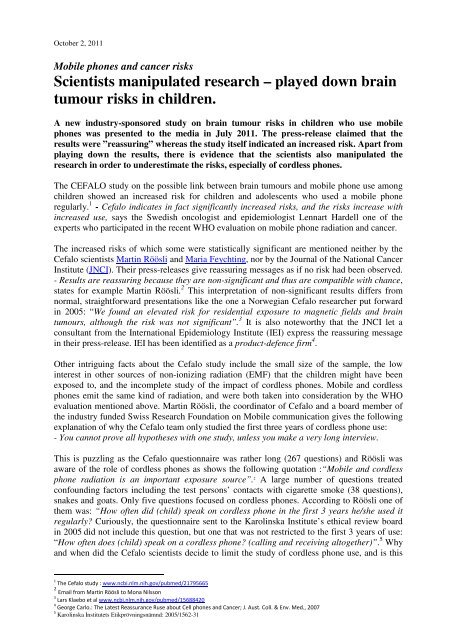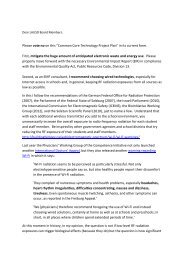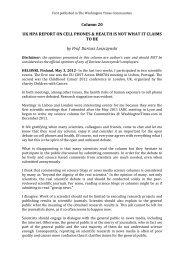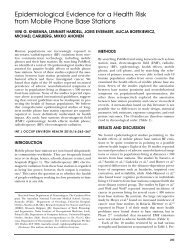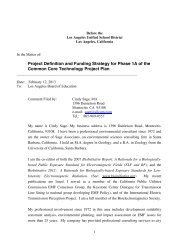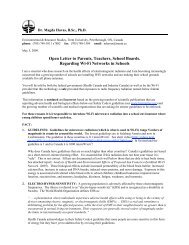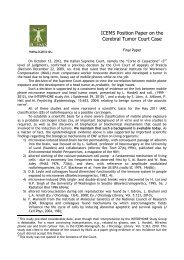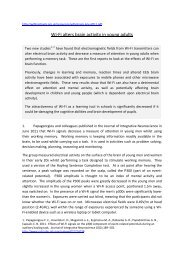Scientists manipulated research ? played down ... - Mona Nilsson
Scientists manipulated research ? played down ... - Mona Nilsson
Scientists manipulated research ? played down ... - Mona Nilsson
Create successful ePaper yourself
Turn your PDF publications into a flip-book with our unique Google optimized e-Paper software.
October 2, 2011<br />
Mobile phones and cancer risks<br />
<strong>Scientists</strong> <strong>manipulated</strong> <strong>research</strong> – <strong>played</strong> <strong>down</strong> brain<br />
tumour risks in children.<br />
A new industry-sponsored study on brain tumour risks in children who use mobile<br />
phones was presented to the media in July 2011. The press-release claimed that the<br />
results were ”reassuring” whereas the study itself indicated an increased risk. Apart from<br />
playing <strong>down</strong> the results, there is evidence that the scientists also <strong>manipulated</strong> the<br />
<strong>research</strong> in order to underestimate the risks, especially of cordless phones.<br />
The CEFALO study on the possible link between brain tumours and mobile phone use among<br />
children showed an increased risk for children and adolescents who used a mobile phone<br />
regularly. 1 - Cefalo indicates in fact significantly increased risks, and the risks increase with<br />
increased use, says the Swedish oncologist and epidemiologist Lennart Hardell one of the<br />
experts who participated in the recent WHO evaluation on mobile phone radiation and cancer.<br />
The increased risks of which some were statistically significant are mentioned neither by the<br />
Cefalo scientists Martin Röösli and Maria Feychting, nor by the Journal of the National Cancer<br />
Institute (JNCI). Their press-releases give reassuring messages as if no risk had been observed.<br />
- Results are reassuring because they are non-significant and thus are compatible with chance,<br />
states for example Martin Röösli. 2 This interpretation of non-significant results differs from<br />
normal, straightforward presentations like the one a Norwegian Cefalo <strong>research</strong>er put forward<br />
in 2005: “We found an elevated risk for residential exposure to magnetic fields and brain<br />
tumours, although the risk was not significant”. 3 It is also noteworthy that the JNCI let a<br />
consultant from the International Epidemiology Institute (IEI) express the reassuring message<br />
in their press-release. IEI has been identified as a product-defence firm 4 .<br />
Other intriguing facts about the Cefalo study include the small size of the sample, the low<br />
interest in other sources of non-ionizing radiation (EMF) that the children might have been<br />
exposed to, and the incomplete study of the impact of cordless phones. Mobile and cordless<br />
phones emit the same kind of radiation, and were both taken into consideration by the WHO<br />
evaluation mentioned above. Martin Röösli, the coordinator of Cefalo and a board member of<br />
the industry funded Swiss Research Foundation on Mobile communication gives the following<br />
explanation of why the Cefalo team only studied the first three years of cordless phone use:<br />
- You cannot prove all hypotheses with one study, unless you make a very long interview.<br />
This is puzzling as the Cefalo questionnaire was rather long (267 questions) and Röösli was<br />
aware of the role of cordless phones as shows the following quotation :“Mobile and cordless<br />
phone radiation is an important exposure source”. 2 A large number of questions treated<br />
confounding factors including the test persons’ contacts with cigarette smoke (38 questions),<br />
snakes and goats. Only five questions focused on cordless phones. According to Röösli one of<br />
them was: “How often did (child) speak on cordless phone in the first 3 years he/she used it<br />
regularly? Curiously, the questionnaire sent to the Karolinska Institute’s ethical review board<br />
in 2005 did not include this question, but one that was not restricted to the first 3 years of use:<br />
“How often does (child) speak on a cordless phone? (calling and receiving altogether)”. 5 Why<br />
and when did the Cefalo scientists decide to limit the study of cordless phone use, and is this<br />
1<br />
The Cefalo study : www.ncbi.nlm.nih.gov/pubmed/21795665<br />
2<br />
Email from Martin Röösli to <strong>Mona</strong> <strong>Nilsson</strong><br />
3<br />
Lars Klaebo et al www.ncbi.nlm.nih.gov/pubmed/15688420<br />
4<br />
George Carlo.: The Latest Reassurance Ruse about Cell phones and Cancer; J. Aust. Coll. & Env. Med., 2007<br />
5<br />
Karolinska Institutets Etikprövningsnämnd: 2005/1562-31
methodologically and ethically acceptable? - Restricting the study to the first three years of use<br />
will lead to an underestimation of risks. We know that telephone use increase with age and that<br />
teenagers talk more than children, says Lennart Hardell.<br />
The elusive press-releases and the sudden restriction of cordless phone use have raised<br />
suspicions of an intentional underestimation of the health risks. Professor Joel Moscowitz,<br />
Director of Center for Family and Community Health, School of Public Health University of<br />
California, questions the conclusions of the Cefalo scientists and the IEI, and claims that the<br />
study was biased. His conclusion finds support in recent history. Several studies reveal that it<br />
has become a widespread practice to use outcome-oriented science to create doubt in order to<br />
postpone regulation and protect the manufacturers. 6<br />
The manufacturer that would be protected in this case is the mobile phone industry. “Any<br />
perceived risk or new scientific findings of adverse health effects of mobile communication<br />
devices and equipment could adversely affect us through a reduction in sales or through<br />
liability claims.” 7 The mobile phone industry’s interest groups are very active in Brussels and<br />
Washington, they are also investing huge amounts in <strong>research</strong> on health effects, including the<br />
Cefalo study. A large majority of the industry-sponsored studies conclude that EMF radiation<br />
is harmless, while most independent studies conclude that there is a risk. 8<br />
Cefalo might have been designed to play <strong>down</strong> risks, but instead of challenging the findings of<br />
the international Interphone group and the Swedish Hardell group, it reconfirms them. These<br />
studies made IARC, the cancer <strong>research</strong> agency of the World Health Organisation, classify<br />
mobile phone radiation as “possibly carcinogenic” in May 2011.<br />
There is now more than enough evidence for an application of the precautionary principle<br />
according to the International EMF Alliance, a public interest NGO representing some 60<br />
grassroots organisations advocating for a regulation and a reduction of electro-pollution.<br />
– The irrational “zero-risk” interpretation of the Cefalo scientists creates doubts and could<br />
postpone preventive measures and cause unnecessary suffering. Mobile phone use has<br />
increased massively among children and teenagers the last decade, and even a small increase<br />
of brain tumour risks is of great concern, says Alex Swinkels, IEMFA board member.<br />
Text: Kerstin Stenberg & <strong>Mona</strong> <strong>Nilsson</strong> priartem.alsace@gmail.com<br />
Research: <strong>Mona</strong> <strong>Nilsson</strong> mona@monanilsson.se<br />
CEFALO FACTS<br />
Sample: Cefalo included 352 children aged 7–19 who were diagnosed with a brain tumour, in the period 2004–<br />
2008 in Sweden, Denmark, Norway and Switzerland, and 646 controls.<br />
Results: Almost all tables indicate an increased risk. The risk was 36% higher for children and adolescents who<br />
used mobile phones regularly. (OR 1,36, CI 0,92-2,02). The risk was amplified by a longer latency time and was<br />
more than twice as high (+115%) for children for whom the longest time had elapsed since they received their first<br />
mobile phone subscription. (OR 2,15, CI 1,07-4,29).<br />
Statistical significance: The odds ratio (OR) measures the odds of an event occurring in a group compared to a<br />
control group. Positive results are considered to be statistically significant when the entire confidence interval (CI)<br />
is above 1. The doubled risk mentioned above is thus significant.<br />
Funding: Partly financed by the industry funded Swiss Research Foundation on Mobile communication<br />
<strong>Mona</strong> <strong>Nilsson</strong> is a Swedish award-winning author and investigation journalist. She revealed that professor Anders<br />
Ahlbom at the Karolinska Institute, Stockholm was a board member of a lobby firm acting for the telecom<br />
industry, while assessing health risks of wireless technologies. This resulted in Ahlbom resigning from two expert<br />
panels in 2011 (IARC and SSM) and amending his declarations of interests. www.monanilsson.se<br />
6<br />
David Michaels; Doubt is their product 2008, TO. McGarity, WE. Wagner, Bending Science, 2008,<br />
7<br />
Ericsson’s annual report 2010.<br />
8<br />
Huss A et al. Source of funding and results of studies of health effects of mobile phone use. Environ Health Perspect. 2007 Jan;115(1):1-4.


